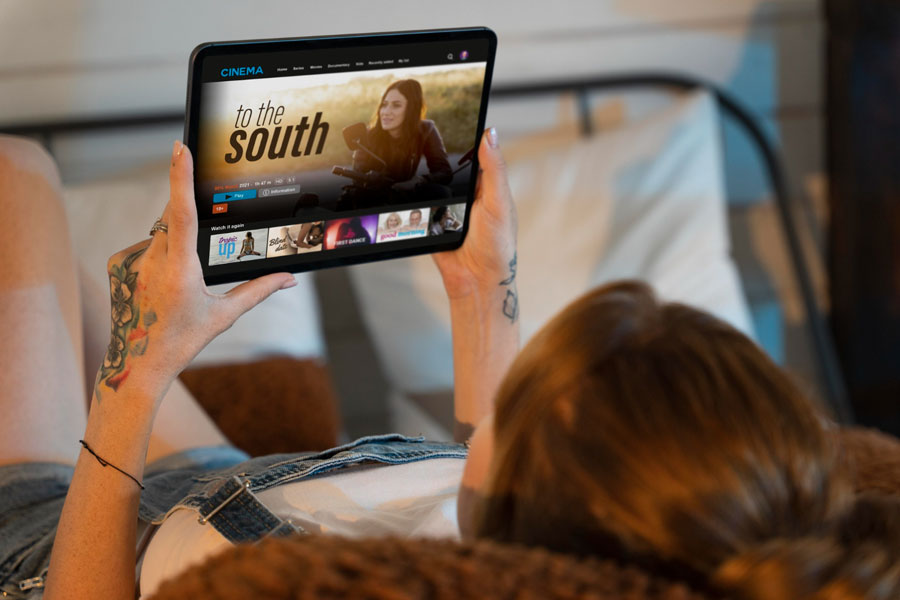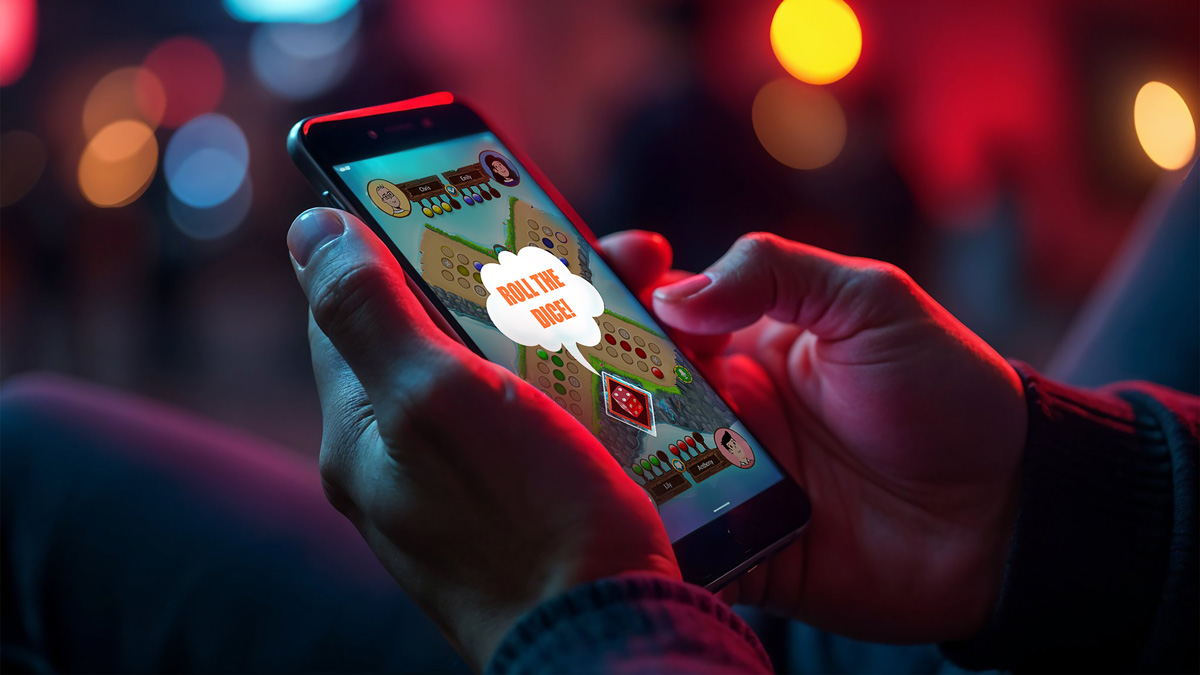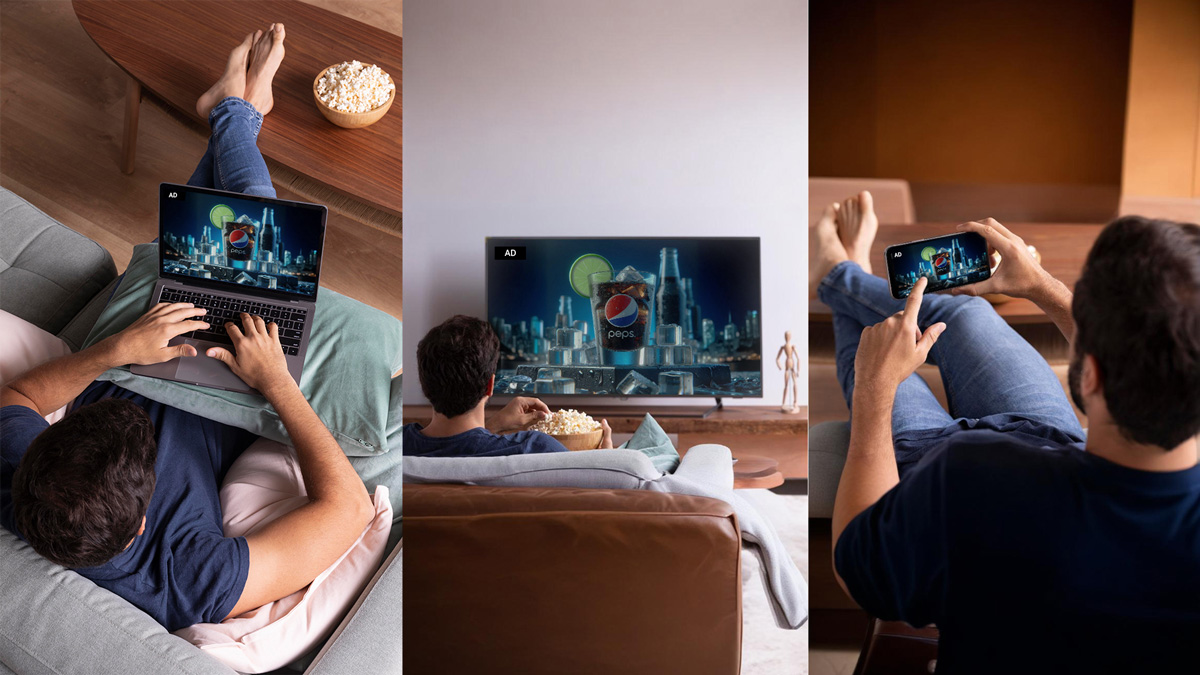
Many people never expected that the way we watch TV would change so much. After all, TV started as a wonder, became a source of entertainment, and almost escaped not being replaced by YouTube, right? Well, not quite.
Yes, TV is still a big source of entertainment, and it’s still overshadowed by the internet for many people. However, it has also evolved, welcoming the internet to overcome the old rigid broadcast schedules and limited content choices. That’s when connected TV (or CTV for short) was born. CTV viewers today have virtually unlimited access to tons of on-demand content, interactive features, and personalized experiences.
But what is connected TV, and why has it become such a sensation in today’s media landscape? In this article, we’ll explore the ins and outs of CTV in the form of sections on what it is, the devices that support it, its benefits, CTV advertising, and more.
Without further ado, let’s dive in.
What is CTV or Connected TV?
First things first: let’s get our facts straight. We’ll start with definitions, then discuss how technology became mainstream and how connected TV differs from traditional TV.
Definition & Basics
Connected TV, often abbreviated as CTV, is any TV that connects to the internet and streams digital content to the viewer. The term goes against traditional TV, which refers to any TV that relies on cable or satellite.
Connected TV (CTV) refers to any television that connects to the internet, allowing viewers to stream digital content directly. Unlike traditional TV, which relies on cable or satellite, CTV offers unrestricted access to a wide range of streaming apps and services. This flexibility is its key advantage, blending the familiar cable TV experience with the vast versatility of the Internet. Viewers can enjoy personalized, on-demand content, all easily accessible with just a few clicks, providing a seamless combination of convenience and variety.

Difference Between CTV & Traditional TV
Now that you know what CTV is, you may be wondering why it’s such a big deal. let’s dig a little deeper.
The key difference between connected TV and traditional TV lies in how content is delivered and consumed. Traditional TV relies on broadcast, cable, or satellite signals that come from the outside at set times. In other words, content on traditional TV is linear and aired according to various schedules. That means that many viewers who really want to catch a show will have to change timetables for it or miss it entirely.
On the other hand, connected TV offers the convenience of choosing what to watch among an ocean of content, when to watch it, and what streaming service to watch it from. The internet is not a signal that goes away, but it stands by until you need something from the web. Plus, it offers more interactivity. Of course, you can pause, rewind, and fast-forward on CTV, but you also have additional content like behind-the-scenes at your fingertips.
One of the key advantages of Connected TV is access to exclusive, premium content. Many networks and production companies now release select movies and shows solely on streaming platforms, bypassing traditional cinemas. This shift presents a significant opportunity for the film industry to reduce the costs associated with cinema distribution, offering a more efficient and direct way to reach audiences.

We’ll talk about the benefits more in their dedicated section below. For now, let’s address a more pressing matter.
Types of CTV Devices
Is connected TV necessarily a TV? It might seem contradictory, but no. The internet connected us as people, but it also did the same with our devices. Connected TV is more like a concept that could apply to many devices. Let’s take a look at three types of these devices in particular.
Smart TVs
Of course, smart TVs are the most common type of connected TV devices. They all have built-in internet connectivity and a number of streaming apps like Hulu, Netflix, YouTube, etc. The specific apps you have vary by manufacturer, but most smart TVs also have an app store where you can download more.
Smart TVs are only getting smarter, too. They’re all user-friendly and intuitive, but they’re still getting more upgrades, from voice control to AI integrations to even more impressive resolutions. As a result, Smart TVs are a popular choice for people looking to upgrade their home entertainment systems.
Streaming Devices (Amazon Fire Stick, Apple TV, etc.)
Love your old TV and don’t want to upgrade to a new one? You can also choose from a range of streaming devices that plug into your TV’s HDMI port and turn it into a Smart TV. There are many devices out there, but Roku, Apple TV, Amazon Fire Stick, and Google Chromecast are among the most popular.
Whichever device you buy, you will have access to a wide selection of apps and services. However, each of them comes with its own functionalities, ecosystem, remote, and looks. For example, Roku has an extensive library of free and paid channels while Apple TV seamlessly integrates into the Apple ecosystem.

These are also popular devices, mostly if your TV doesn’t connect to the internet or has gone out of date and you don’t want to spring for a new model. Just get one of these, and you’re connected!
Gaming Consoles
Gone are the days when gaming consoles were just for games! With the emergence of powerful titles that shook both the gaming industry and cinema, video game consoles have earned a lot of attention and evolved to become full-fledged entertainment hubs.
We’re specifically talking about PlayStation, Xbox, and Nintendo Switch. As you know or have guessed, these consoles also support a wide range of streaming apps that let you watch movies, TV shows, and live events in addition to playing memorable games.
Gaming consoles are also popular for two reasons: added functionalities and great performance. First, each console comes with its own services like PlayStation Vue for exclusive content or Dolby Atmos support for immersive sound. Second, gaming consoles come with sophisticated hardware and software meant to run games smoothly. The extra benefit is that you will experience little or no lag in accessing CTV content!
Benefits of CTV for Consumers
So far, we’ve gathered that connected TV is a new, impressive realm. But what does it bring to the consumer?
Here’s a rundown of its top benefits.
On-Demand Content
As we’ve briefly mentioned, this used to be the biggest selling point of the first CTV devices. Play what you want when you want it. (Compare this with traditional TV, where viewers have to play by a network’s timetable, not the other way around.)
This flexibility is especially appealing in today’s consumer-centric, fast-paced world. CTV puts the viewer in charge of their time and attention, whether to binge-watch that old series or to catch a missed episode of a new one.
On-demand content also means each streaming service includes a vast library of movies, documentaries, and special events, ensuring that there’s always something available for every mood.
Quality & Innovation in Content
The disruptive nature of the internet and connected TV has also significantly elevated the quality and innovation in produced media. This is the second significant benefit of connected TV, which is itself twofold.
First, creators are no longer bound by the traditional schedules and network guidelines. They’re now free to be truly creative and experiment with new formats, genres, and techniques. As a result, we have a surge in innovative programming.
Second, streaming platforms are now in a constant battle to win over viewers. As a result of this battle, they invest heavily in original content, pay attention to what works and what doesn’t, and strive for customer satisfaction at its finest. Contrast this with cable TV, where it was that show you don’t like or nothing!
In essence, as the intersection of the internet and television, CTV has transformed how we watch TV and also ushered in a new golden age of television, characterized by innovation, diversity, and exceptional quality.
Personalization
A third advantage of CTV is the high level of personalization it comes with. Streaming platforms know all about online advertising and analytics, so they have algorithms in place to track a user’s preferences and viewing habits and offer them an individualized curation of content.
It’s like YouTube or Spotify. The more you interact with the content you love, the better the algorithm gets at what to recommend to you next. Many streaming platforms also allow multiple profiles per account, so everyone in a household can get their unique curation without paying for additional accounts.
Note that streaming platforms aren’t the only players in CTV; it’s all much bigger.
The CTV Ecosystem
Each CTV device works like any other device capable of connecting to the internet, so that’s no mystery. But it’s worth taking a little time to consider the entire ecosystem of entities involved in keeping connected TV up and running. It’ll help inform the discussion on CTV advertising and challenges.
There are four major players in the CTV ecosystem: content providers, streaming platforms, device manufacturers, and viewers.
Content Providers
Content providers are the people who create and distribute the media available on CTV platforms. They’re the ones who produce movies, TV shows, documentaries, and live events that we all love so much.
These people are primarily categorized into two groups:
- Major content providers that include traditional networks like NBC, CBS, and BBC, as well as streaming giants like Netflix, Hulu, Amazon, Disney, etc., and
- Many independent creators and studios who produce content specifically for digital platforms, contributing to the vast landscape of CTV programming.
The role of content providers is crucial because they supply the material that drives viewer engagement and sustains the CTV ecosystem.
Streaming Platforms
Content providers are primarily people involved in the creation of the next blockbusters. On the other hand, streaming platforms are how viewers get to watch those blockbusters. These consist of people behind aggregating and delivering content on platforms like Netflix, Hulu, Disney+, Amazon Prime Video, HBO Max, and more where viewers can find tons of content and browse them to find exactly what they want.
What’s notable about these platforms is that the competition among them is fierce. Each of them aims to steal the ball from its competitors by offering a uniquely growing catalog of titles that sometimes also includes original content from exclusive content providers.
Whether a streaming platform succeeds or fails depends solely on its value proposition. That primarily comes down to its diverse range of content, a seamless user experience, and compatibility with as many CTV devices as possible.
Device Manufacturers
CTV wouldn’t exist without the appropriate hardware that connects TVs to the internet and streams content from it. Device manufacturers are those that make Smart TVs, streaming devices, and gaming consoles.
Leading companies in the field are Samsung, Amazon, LG, Sony, Apple, and some others, each controlling a slice of the market and catering to the needs of their own audience. The competition here is also notable, driving innovation and resulting in more affordable, feature-rich devices.
Viewers
At the heart of the CTV ecosystem are the viewers, the consumers of the content and buyers of the devices. Connected TV allows them the flexibility of choosing what to watch, when to watch it, and how to engage and interact with it.
In fact, it is these engagements that really fuels the entire ecosystem. Take ratings and comments, for example. If a show proves popular with a certain audience, content providers reap the rewards, streaming services know what to advertise, and device manufacturers can leverage the insight to better target the markets.
How CTV Advertising Works
In this section, we’ll take a brief look at connected TV advertising. It’s in our wheelhouse.
Targeted Advertising
Targeted advertising is a feature that comes with the internet, and so is native to CTV. This is when the advertiser takes a data-driven approach and chooses to deliver their ads to users who might find it interesting.
Remember that traditional TV relied on signals sent to everyone at a set time, so this advertising mode wasn’t at all possible and everyone saw the same ads at the same times. CTV does care for individual preferences, and so CTV advertising leverages user data to deliver relevant ads. Advertisers can target users based on demographics, viewing history, and even location. It’s not unlike other online targeted ads.
Programmatic Advertising
With CTV being so popular, there’s naturally a limited number of ads that can be shown. This is where programmatic advertising comes in as another key feature of CTV, allowing advertisers to automate the buying and placement of ads in real-time.
A programmatic ad platform at a connected advertising agency relies on sophisticated algorithms to match ads with available inventory on streaming platforms. This ensures that the right ads are shown to the right people and also increases the efficiency of ad campaigns, because advertisers get to see real-time data of ad performance and optimize their campaigns as they see fit.
Challenges in CTV
In this last section of the article, let’s discuss CTV challenges and how the ecosystem can get better in the future.
Fragmentation
One of the biggest challenges in the CTV landscape is that it’s highly fragmented. While we all know major players in the field, there are way too many streaming services, devices, and content providers across the globe.
This is particularly an issue for advertisers, because it could make it difficult for them to reach a consistent audience across all devices, platforms, and geographic locations.
Privacy Concerns
CTV is part of the internet, so privacy concerns are also a significant issue. We mentioned that platforms and devices use user data for targeted advertising, which brings up many questions. What data is collected? How is it stored? How long does it stay in storage? How is it used? Is there a way to permanently erase it? What if there’s a leak?
Transparency and communication with the viewers are crucial to maintaining trust. Still, privacy remains a major issue on the internet as a whole. The good news is that it’s starting to get the attention that it deserves. For example, you may look up your streaming device on Mozilla’s Privacy Not Included to see how your information is collected and handled.
Ad Fraud
Although CTV is generally seen as a more secure environment than traditional digital advertising, ad fraud could still be an issue. Think about bot traffic, fake impressions, ad stacking, and how they affect advertising campaigns.
We advise advertisers to work with trusted agencies and platforms and employ advanced fraud detection tools until a more permanent solution is found.
Final Word
Connected TV (CTV) is reshaping the way we consume media and how brands reach their audiences. In this piece, we’ve covered the basics of this vast landscape and what it brings to consumers and businesses.
If you need help with CTV advertising, feel free to contact us for advice!
Arya



